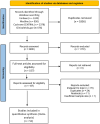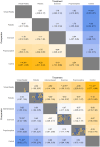Innovative technology-based interventions in Parkinson's disease: A systematic review and meta-analysis
- PMID: 39236299
- PMCID: PMC11514937
- DOI: 10.1002/acn3.52160
Innovative technology-based interventions in Parkinson's disease: A systematic review and meta-analysis
Abstract
Objective: Novel technology-based interventions have the potential to improve motor symptoms and gait in Parkinson's disease (PD). Promising treatments include virtual-reality (VR) training, robotic assistance, and biofeedback. Their effectiveness remains unclear, and thus, we conducted a Bayesian network meta-analysis.
Methods: We searched the Medline, Embase, Cochrane CENTRAL, and Clinicaltrials.gov databases until 2 April 2024 and only included randomized controlled trials. Outcomes included changes in UPDRS-III/MDS-UPDRS-III score, stride length, 10-meter walk test (10MWT), timed up-and-go (TUG) test, balance scale scores and quality-of-life (QoL) scores. Results were reported as mean differences (MD) or standardized mean differences (SMD), with 95% credible intervals (95% CrI).
Results: Fifty-one randomized controlled trials with 2095 patients were included. For UPDRS (motor outcome), all interventions had similar efficacies. VR intervention was the most effective in improving TUG compared with control (MD: -4.36, 95% CrI: -8.57, -0.35), outperforming robotic, exercise, and proprioceptive interventions. Proprioceptive intervention significantly improved stride length compared to control intervention (MD: 0.11 m, 95% CrI: 0.03, 0.19), outperforming VR, robotic and exercise interventions. Virtual reality improved balance scale scores significantly compared to exercise intervention (SMD: 0.75, 95% CrI: 0.12, 1.39) and control intervention (SMD: 1.42, 95% CrI: 0.06, 2.77). Virtual reality intervention significantly improved QoL scores compared to control intervention (SMD: -0.95, 95% CrI: -1.43, -0.52), outperforming Internet-based interventions.
Interpretation: VR-based and proprioceptive interventions were the most promising interventions, consistently ranking as the top treatment choices for most outcomes. Their use in clinical practice could be helpful in managing motor symptoms and QoL in PD.
© 2024 The Author(s). Annals of Clinical and Translational Neurology published by Wiley Periodicals LLC on behalf of American Neurological Association.
Conflict of interest statement
The authors do not have any competing financial interests or personal relationships that could have appeared to influence the work reported in this paper.
Figures






References
Publication types
MeSH terms
Grants and funding
LinkOut - more resources
Full Text Sources
Medical
Research Materials
Miscellaneous

